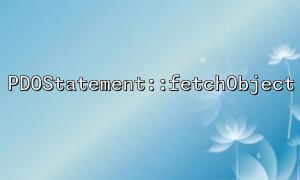In database development, it is very common to use PDO to perform SQL queries and return data. PDO provides the PDOStatement::fetchObject method, allowing us to map query results into objects, making it convenient for data processing and operation. However, when the field name does not exactly match the object attribute, how can the mapping be achieved through column alias? This article will explore how to use column alias to map database query results to object properties, thereby achieving more flexible data processing.
The PDOStatement::fetchObject method allows you to map query results directly into PHP objects. When using this method, PDO tries to map column names in the database table to the object's properties. The basic usage is as follows:
$pdo = new PDO('mysql:host=localhost;dbname=test', 'user', 'password');
$query = $pdo->query("SELECT * FROM users");
while ($user = $query->fetchObject()) {
echo $user->name; // Output result
}
In the above example, fetchObject maps each row of the query result into a PHP object where the column name (such as name ) becomes the object's property.
In actual development, the column names in the database table may be inconsistent with the object's attribute names. At this time, you can use column alias in SQL queries to help with the mapping. Through the AS keyword, we can specify an alias for the column to be consistent with the object's attribute name.
Suppose there is the following database table structure:
CREATE TABLE users (
id INT PRIMARY KEY,
username VARCHAR(50),
email VARCHAR(100)
);
When mapping query results as objects, you may need to map username to name attribute and email to email_address attribute. To achieve this we can use column alias.
We can use the AS keyword in SQL query to specify column aliases to ensure that the column names in the query results match the object attributes.
class User {
public $id;
public $name;
public $email_address;
}
$pdo = new PDO('mysql:host=localhost;dbname=test', 'user', 'password');
$query = $pdo->query("SELECT id, username AS name, email AS email_address FROM users");
while ($user = $query->fetchObject('User')) {
echo $user->name . ' - ' . $user->email_address;
}
In this example, we use the SQL column alias AS name and AS email_address to map username and email to the name and email_address properties in the User class. In this way, the query results can be mapped directly to the User object without manually adjusting the matching of the column name and the attribute name.
If you want to handle the mapping between column names and object properties flexibly in more complex scenarios, you can build queries dynamically, or define a mapping rule in your application.
For example, suppose we want to generate column alias dynamically based on a certain condition, we can use the following method:
$columnMapping = [
'username' => 'name',
'email' => 'email_address'
];
$selectColumns = [];
foreach ($columnMapping as $column => $alias) {
$selectColumns[] = "$column AS $alias";
}
$selectColumnsString = implode(", ", $selectColumns);
$query = $pdo->query("SELECT $selectColumnsString FROM users");
while ($user = $query->fetchObject('User')) {
echo $user->name . ' - ' . $user->email_address;
}
In this example, we use an array $columnMapping to dynamically build column aliases, so that the mapping between column names and object properties can be flexibly adjusted as needed.
By using column aliases in SQL queries, we can easily map column names in the database to the properties of the object, making data processing more flexible and convenient. Combined with PDOStatement::fetchObject , we can map query results directly into objects, further simplifying the code and improving readability. In actual development, the flexibility to use column alias can help you solve many common data processing problems, especially when column names are inconsistent.
Related Tags:
PDOStatement














